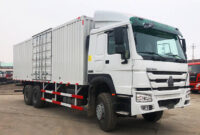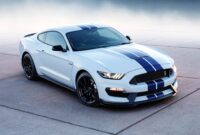1948-53 Chevy Trucks For Sale: Your Comprehensive Guide to Owning an American Icon pickup.truckstrend.com
Few vehicles embody the spirit of post-war America quite like the Chevrolet Advanced Design series trucks, produced from late 1947 through early 1955. Among these, the 1948-1953 models stand out as particularly iconic, representing a sweet spot in design evolution and mechanical simplicity. These trucks, with their rounded fenders, distinctive grilles, and robust utility, weren’t just workhorses; they were a symbol of a nation rebuilding and thriving. Today, "1948-53 Chevy Trucks For Sale" isn’t just a search query; it’s an entry point into a vibrant community of enthusiasts, restorers, and customizers eager to preserve, personalize, and drive a piece of automotive history.
Whether you’re dreaming of a fully restored showpiece, a reliable daily driver with vintage charm, or a blank canvas for a custom hot rod, understanding the nuances of these beloved trucks is crucial. This guide will delve into everything you need to know about finding, evaluating, and ultimately owning a 1948-53 Chevy truck.
1948-53 Chevy Trucks For Sale: Your Comprehensive Guide to Owning an American Icon
The Enduring Appeal of Advanced Design Trucks
The popularity of 1948-53 Chevy trucks is multifaceted. Firstly, their timeless aesthetic strikes a chord with enthusiasts of all ages. The sleek, streamlined design, a significant departure from pre-war models, blended utility with a newfound sense of style. The "Advanced Design" moniker wasn’t just marketing; it reflected genuine innovation in comfort and visibility compared to previous generations.
Secondly, their simplicity and robustness make them incredibly appealing to collectors and DIY mechanics. Built during an era when vehicles were designed to be repaired, not just replaced, these trucks are relatively straightforward to work on. Parts availability, both original and aftermarket, is excellent, making restoration and customization projects feasible.
Finally, the versatility of these trucks is unmatched. From their original role as farm and utility vehicles to their modern incarnations as street rods, restomods, or even reliable daily drivers, their adaptability allows for a wide range of uses and personal expressions. They evoke a sense of nostalgia, a simpler time, and the enduring quality of American manufacturing.
Identifying the Years: Subtle Nuances
While sharing a common "Advanced Design" lineage, the 1948-53 Chevy trucks feature subtle year-to-year differences that can help identify them and influence their value or desirability for specific projects.
- 1948-Early 1951: These models are characterized by their non-vented "no-draft" side windows and push-button exterior door handles. The grille generally featured horizontal bars.
- Mid-1951-1953: A significant mid-year change in 1951 introduced vent windows (small triangular glass panes that pivot for ventilation) and new pull-out style exterior door handles. The 1952 model saw the return of a push-button style door handle, but it was integrated differently into the new handle design. The 1953 model year is largely similar to 1952 but might have minor trim differences or steering wheel variations.
- Grille Variations: While generally similar, subtle changes in grille bar count or emblem placement occurred. For instance, some 1947-48 models had a different "Chevrolet" script on the hood side compared to later years.

Understanding these distinctions is important for authenticity if you’re aiming for a period-correct restoration, or simply to appreciate the evolution of the design.
Common Configurations and Body Styles
When searching for 1948-53 Chevy trucks for sale, you’ll encounter several common configurations:
- 3100 Series (Half-Ton): This is by far the most popular and sought-after model, recognizable by its short wheelbase and 6.5-foot bed. Ideal for cruising, custom builds, and general utility.
- 3600 Series (Three-Quarter-Ton): Featuring a longer wheelbase and an 8-foot bed, these trucks offer increased hauling capacity. They are less common than the 3100 but are excellent for those needing more utility or a distinct look.
- 3800 Series (One-Ton): The heaviest duty pickup, often with dual rear wheels (duallies) and a larger 9-foot bed. These are rarer and often favored by collectors for their unique presence.
- Panel Trucks: Enclosed utility vehicles without rear windows, popular for commercial use or as unique custom builds.
- Suburban Carryall: The ancestor of modern SUVs, these passenger wagons offered seating and cargo space, making them highly desirable and often commanding higher prices.
- Canopy Express: A pickup with a canvas or metal roof over the bed, often used for deliveries. Less common.
- Cab Over Engine (COE): While less common for casual buyers, these distinctive forward-control trucks were used for heavy hauling and are a niche collector’s item.

The 3100 pickup is the most prevalent in the "for sale" market, offering the widest range of conditions and price points.
What to Look For When Buying: A Critical Checklist
Purchasing a vintage truck requires careful inspection. Here’s what to prioritize:
- Rust, Rust, Rust: This is the primary enemy of these trucks.
- Cab: Check cab corners, lower door skins, floorboards (especially under the mat), and the cowl area where the fenders meet the cab.
- Fenders: Front and rear fenders are prone to rust, particularly around the wheel wells and mounting points.
- Bed: Look for rot in the bed floor (often wood), bed sides, and cross sills.
- Frame: Critically inspect the frame rails for cracks, bends, or significant rust pitting, especially near suspension mounts and crossmembers. A compromised frame is a major red flag.
- Mechanical Condition:
- Original Drivetrain: If it has the original 216 or 235 cubic inch inline-six engine, check for leaks, excessive smoke, and listen for unusual noises. Test the manual transmission (3-speed "three-on-the-tree" or 4-speed) for smooth shifting.
- Swapped Drivetrain (Restomod): If it’s been converted to a modern V8 (most commonly a Small Block Chevy) and automatic transmission, inquire about the quality of the swap. Check wiring, mounts, and cooling system.
- Suspension & Steering: Look for worn bushings, leaf spring condition, and excessive play in the steering. Many restomods will have updated independent front suspension (IFS).
- Brakes: Original drum brakes are adequate but can be upgraded to discs for better stopping power. Ensure they feel firm and stop the truck straight.
- Electrical System: Original wiring can be brittle and prone to shorts. Check all lights, gauges, and the horn. A common upgrade is a 12-volt conversion from the original 6-volt system.
- Interior: Assess the condition of the seat (upholstery and springs), dashboard (cracks, missing gauges), steering wheel, and door panels. Original gauges are often faded or non-functional.
- Documentation: A clear, transferable title is paramount. Any historical documentation, build receipts, or service records add value and peace of mind.
Restoration vs. Restomod vs. Driver: Defining Your Vision
Before you start looking, decide what kind of truck you want:
- Full Restoration: Aims to bring the truck back to its factory-original condition, using period-correct parts, paint, and materials. This is for purists and can be extremely costly and time-consuming. These often command the highest prices for their authenticity.
- Restomod: Combines classic aesthetics with modern performance, comfort, and reliability. This often involves engine swaps (V8s), updated transmissions (automatics), power steering, disc brakes, air conditioning, and modern suspension. Restomods are highly popular for their drivability and can range from mild upgrades to full custom builds.
- Driver: A functional truck that runs and drives, but might have cosmetic imperfections, minor mechanical quirks, or a "patina" finish (original weathered paint). These are often the most affordable entry point and can be enjoyed immediately, with gradual improvements over time.
- Project: A truck that requires significant work to be roadworthy. This could be a rolling chassis, a rusty body, or a non-running vehicle. Best for those with significant mechanical skills, a large budget for parts, and ample time.
Your budget, mechanical skill level, and intended use will dictate which category is right for you.
Where to Find Your Dream Truck
The market for 1948-53 Chevy trucks is robust, offering several avenues for finding your next project or finished classic:
- Online Marketplaces:
- ClassicCars.com, Hemmings.com, AutoTraderClassics.com: Dedicated classic car and truck listings, often with detailed descriptions and photos.
- eBay Motors: A wide range of conditions, from parts trucks to fully restored examples. Be wary of sellers with poor feedback.
- Bring a Trailer (BaT): Curated auctions for higher-end vehicles, often with extensive photo galleries and community discussion.
- Facebook Marketplace & Dedicated Groups: Many active groups dedicated to Advanced Design Chevy trucks where owners buy, sell, and trade.
- Specialized Dealers: Reputable classic car dealers often have a selection of restored or well-maintained trucks, though prices will be higher to account for their overhead and expertise.
- Auctions: Live auctions (Mecum, Barrett-Jackson) and online auction houses can be good sources, but inspect the vehicle thoroughly before bidding.
- Word of Mouth/Local Classifieds: Sometimes the best deals are found through local connections or old-fashioned classifieds.
Navigating the Purchase Process
Once you’ve found a potential truck, follow these steps:
- Thorough Inspection: If possible, inspect the truck in person. Bring a knowledgeable friend or hire a pre-purchase inspection (PPI) service, especially if the truck is far away.
- Ask Questions: Inquire about the truck’s history, any previous accidents, recent maintenance, and why the seller is parting with it.
- Test Drive: If the truck is running, take it for a drive. Listen for unusual noises, check braking, steering, and transmission operation.
- Negotiation: Be prepared to negotiate, but also be realistic about the truck’s condition and market value.
- Secure Payment & Title Transfer: Ensure you receive a clear title signed over to you. Use secure payment methods.
- Transportation: Plan how you’ll get the truck home, especially if it’s a non-runner or a long distance away.
Price Table: 1948-53 Chevy Trucks For Sale (Estimated Ranges)
| Year Range | Model (Common) | Condition Category | Estimated Price Range (USD) | Notes |
|---|---|---|---|---|
| 1948-1953 | 3100 (1/2-Ton) | Project/Parts | $3,000 – $12,000 | Rolling chassis, significant rust, non-running, missing parts. Good for complete overhauls. |
| 1948-1953 | 3100 (1/2-Ton) | Driver Quality | $12,000 – $30,000 | Runs, drives, stops. Cosmetic flaws, minor mechanical needs. Usable as-is or for gradual improvement. |
| 1948-1953 | 3100 (1/2-Ton) | Restored (Good) | $30,000 – $55,000 | Professional restoration, period-correct, excellent paint, chrome, and interior. Strong mechanicals. |
| 1948-1953 | 3100 (1/2-Ton) | Restored (Show) | $55,000 – $80,000+ | Concours-level restoration, meticulous detail, perfect originality. Investment-grade. |
| 1948-1953 | 3100 (1/2-Ton) | Restomod (Mild) | $35,000 – $65,000 | Modern engine/trans, disc brakes, power steering. Good daily driver. |
| 1948-1953 | 3100 (1/2-Ton) | Restomod (High-End) | $65,000 – $150,000+ | Custom chassis, modern suspension, high-performance engine, custom interior, show-quality finish. |
| 1948-1953 | 3600 (3/4-Ton) | Driver/Restored | $10,000 – $45,000 | Generally lower prices than 3100 due to lower demand, but can vary by condition. |
| 1948-1953 | 3800 (1-Ton) | Driver/Restored | $15,000 – $50,000 | Rarer, niche market. Prices can fluctuate. |
| 1948-1953 | Panel/Suburban | Driver/Restored | $25,000 – $100,000+ | Highly desirable, especially Suburbans. Prices vary greatly by condition and originality. |
Disclaimer: These are approximate price ranges and can vary significantly based on location, market demand, specific year/features, originality, and the quality of any restoration or modification work.
Frequently Asked Questions (FAQ)
Q: Are parts readily available for 1948-53 Chevy trucks?
A: Absolutely! Thanks to their popularity, the aftermarket support is excellent. You can find almost any body panel, trim piece, mechanical component, or interior part new or used. Many original parts are also still available.
Q: Can a 1948-53 Chevy truck be a reliable daily driver?
A: An original truck, with its 6-volt system, drum brakes, and manual steering, can be driven daily but requires more driver input and regular maintenance. A "restomod" version, with modern drivetrain, brakes, and power steering, can be very reliable and comfortable for daily use.
Q: What are common upgrades for these trucks?
A: Popular upgrades include: V8 engine swaps (especially Small Block Chevy), automatic transmissions, power steering, disc brake conversions, independent front suspension (IFS) kits, 12-volt electrical conversions, and air conditioning.
Q: How do I decode the VIN or serial number on these trucks?
A: The serial number (VIN) on 1948-53 Chevy trucks is typically found on a plate on the driver’s side door jamb. It usually indicates the assembly plant, series (e.g., 3100), and sequential production number. Online resources and forums can help you decipher specific numbers to confirm the year and original configuration.
Q: Are these trucks difficult to maintain?
A: For original trucks, maintenance is relatively simple due to fewer complex electronics. Basic mechanical skills are helpful. For restomods, maintenance depends on the modern components used. In either case, regular checks of fluids, brakes, and tires are essential.
Conclusion
The 1948-53 Chevy Advanced Design trucks are more than just old vehicles; they are a canvas for personal expression, a tangible link to a pivotal era, and a source of immense enjoyment for their owners. Whether you envision a perfectly polished show truck, a gritty patina’d workhorse, or a high-performance custom, the journey of acquiring and nurturing one of these American icons is incredibly rewarding. With careful research, a keen eye for detail, and a clear vision, you can find the perfect 1948-53 Chevy truck for sale and embark on your own piece of automotive history.




